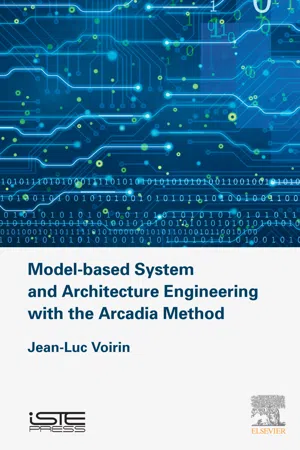
- 388 pages
- English
- ePUB (mobile friendly)
- Available on iOS & Android
Model-based System and Architecture Engineering with the Arcadia Method
About this book
Arcadia is a system engineering method based on the use of models, with a focus on the collaborative definition, evaluation and exploitation of its architecture.This book describes the fundamentals of the method and its contribution to engineering issues such as requirements management, product line, system supervision, and integration, verification and validation (IVV). It provides a reference for the modeling language defined by Arcadia.The author discusses the range of applications, from the assessment of different architectures and their suitability, to the collaboration between system engineering, specialties such as safety or security, subsystems engineering teams, software and hardware. This is illustrated by several examples of representative models which constitute a common thread.- Offers a comprehensive examination of systems engineering, including the use of models to support it- Not only yet another book on modeling, but rather a journey in systems engineering, enlightening the use of models to support it.- Focuses on solitary modeling tasks while also covering prime collaborations between engineering stakeholders- Examines modeling techniques to capture and share architecture and to early verify it against need and non-functional constraints- Addresses subjects not usually covered by model-based system engineering (MBSE) methods, such as co-engineering with specialties, system/sub-system co-engineering, integration verification and validation- Features a powerful, dedicated tool (Capella)- Covers a range of topics, including an introduction to system engineering issues, an introduction to MBSE, a presentation of the method for beginners and a handy reference manual for advanced users
Frequently asked questions
- Essential is ideal for learners and professionals who enjoy exploring a wide range of subjects. Access the Essential Library with 800,000+ trusted titles and best-sellers across business, personal growth, and the humanities. Includes unlimited reading time and Standard Read Aloud voice.
- Complete: Perfect for advanced learners and researchers needing full, unrestricted access. Unlock 1.4M+ books across hundreds of subjects, including academic and specialized titles. The Complete Plan also includes advanced features like Premium Read Aloud and Research Assistant.
Please note we cannot support devices running on iOS 13 and Android 7 or earlier. Learn more about using the app.
Information
Motivations, Background and Introduction to Arcadia
Abstract
Keywords
1.1 Context and challenges
1.2 A bit of history: the creation of a method
1.2.1 Evolution of engineering
1.2.2 2001–2006: First experiments using a model-based approach
Table of contents
- Cover
- Title page
- Table of Contents
- Dedication
- Copyright
- Preface
- Part 1: Foundations of the Method: General Approach and Major Prospects
- Part 2: Method in Action: Using Engineering Models
- Part 3: Encyclopedia of the Language and Glossary of the Concepts of Arcadia
- Conclusion and Perspectives
- Appendix: Introduction to Capella: The Benchmark Modeling Tool for Arcadia
- Bibliography
- Index